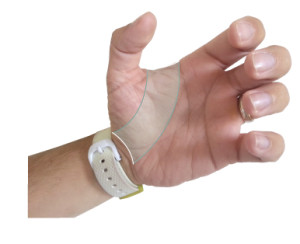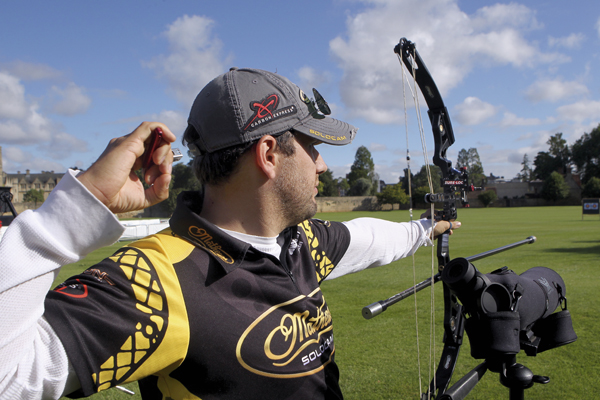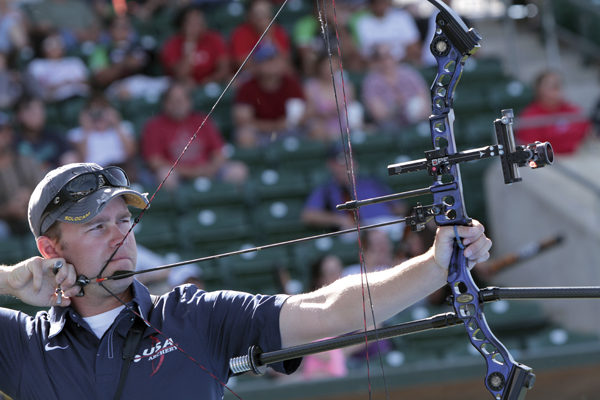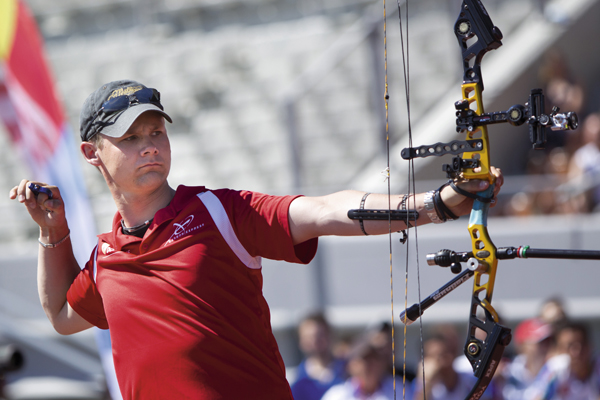Duncan Busby says a correct grip is vital to accurate shooting, and explains how to find your perfect placement
Since the main contact point between an archer and their bow is through the grip, how you hold your bow can determine the accuracy and consistency of your results, and even the likelihood of injury.
Although it’s often an area that’s overlooked it’s critically important that you achieve a good hand position, so how do you do this?
The foundation for good hand placement is to have the bow grip running through the fleshy part of your hand, often referred to as the thumb pad, so it sits on the thick, muscular part of your thumb between the joint and the rest of your palm. This position should ensure that the bow has a solid footing to push against at full draw; the pressure of the bow should be transferred in a straight line from your hand, through to your wrist, up your arm and into your shoulder, so it is evenly distributed and no one area supports the full weight of the draw.
Getting this right can be easier said than done and everyone’s hands are different, so a simple way of finding this optimum position it is use the ‘life’ line on the palm of your hand as a reference point. This is the crease that runs between your thumb and index finger down to the centre of your wrist. Keep your bow’s grip on the thumb side of your life line – if the grip strays too far into the palm of your hand, you can find the extra contact causes inconsistent pressures on the bow; you may twist or torque the handle which will affect your arrow groups to the left and right, or you risk heeling the bow upon release, which will cause your shots to hit high or low depending on the contact you make on the bottom of the bow’s grip.
In contrast, if you hold the bow too far onto your thumb joint you will create muscle tension in your hand and wrist, which can result in fatigue or even injury. As the bones are more prominent in this part of your hand it will also create an uneven platform for the handle to sit against, which again can cause inconsistent results.

The pressure of the grip should be transferred through your wrist and arm and into your shoulder, so the weight is evenly distributed
When you are at full draw, the tension in the string will force the bow to align itself in a certain direction. When you release, this tension vanishes and the bow aligns itself in whatever direction your hand position suggests, so it is important that you don’t affect the balance of the grip. Creating a flat, relaxed platform against the riser will give you the best chance of keeping your bow – and subsequently your arrow – in line with the target. With this mind, consider the placement of your fingers; their exact position is less important as long as they remain relaxed throughout the entire shot process. Let them sit wherever is comfortable, but they must not obstruct either your bow or arrow.
Be aware of handle grabbing, which is an involuntary wrist and hand movement that causes the archer to snatch the bow upon release. To counteract it I’d recommend using a bow or finger sling to catch your bow. I often see archers tucking their fingers down the side of the grip in an attempt to remove any possibility of this kind of interference, but the tension required by the fingers to maintain such a position can create inconsistent results; some may find their fingers naturally sit in this position, which is fine, as long as your finger placement remains relaxed you should chose whatever position feels most natural to you.
Your thumb should also sit in whatever position is most comfortable; though this is usually dictated by your bow’s grip design. Your thumb merely provides an enclave for the bow to sit in; as long as it is relaxed almost anything goes.
You will find that no two compound archers shoot exactly alike and though coaches can have a tendency to cite a one-size-fits-all rule, there is no one way that a compound archer should be shooting. Personally, I cannot get my knuckles to sit at a 45-degree angle, nor can I point my thumb towards the target without creating tension. Remember, the key to a consistent, accurate shot is a relaxed bow hand.
Manufacturers, too, produce grips in more than one style; these can require different hand positions and are more of a personal choice. If you maintain a relaxed stance any grip design or hand position can bring you archery success.

If the grip strays too over the line into the palm of your hand the extra contact can cause inconsistent on the bow
Unlike a recurver, a compound archer must contend with varied bow designs, which are often reflexed, along with let-off in their holding weight that can increase the likelihood of torque, so any amount of uneven pushing or gripping from your bow hand risks creating inconsistent pressures that can affect your arrow flight and groups.
Tension leads to tension, and any amount of stress in your bow hand can be transferred to your arm and shoulder which can lead to muscle fatigue, aiming issues, and eventually injury, so it is important to maintain a relaxed shooting form; this begins with your bow hand.
No archer can be successful at the sport without learning the art of consistency. Practice placing your hand in the same part of the bow every time before shooting. Take the time to make sure that your grip tension and finger placement is the same before drawing the bow each and every time you shoot. Even small variations in your hand placement and grip can lead to major inaccuracies in your shot.
Learning correct bow hand position is a foundation for your entire shot: creating a solid platform for your bow will vastly improve your performance and your stamina, and reduce your risk of injury, so spend some time working on your hand position and find out the difference you can make to your shooting.
www.duncanbusbyarchery.com
[email protected]






Never thought about this until now, but it’s actually so important. Great post, really interesting read xxx